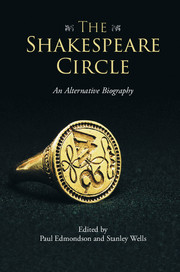Book contents
- Frontmatter
- Contents
- List of illustrations
- List of contributors
- Preface and acknowledgements
- General introduction
- Part I Family
- Part II Friends and Neighbours
- 12 A close family connection: the Combes
- 13 Schoolfriend, publisher and printer Richard Field
- 14 Living with the Mountjoys
- 15 Ben Jonson
- 16 Richard Barnfield, John Weever, William Basse and other encomiasts
- 17 Last things: Shakespeare's neighbours and beneficiaries
- Part III Colleagues and Patrons
- Closing remarks
- Afterword
- Index
- References
15 - Ben Jonson
from Part II - Friends and Neighbours
Published online by Cambridge University Press: 05 November 2015
- Frontmatter
- Contents
- List of illustrations
- List of contributors
- Preface and acknowledgements
- General introduction
- Part I Family
- Part II Friends and Neighbours
- 12 A close family connection: the Combes
- 13 Schoolfriend, publisher and printer Richard Field
- 14 Living with the Mountjoys
- 15 Ben Jonson
- 16 Richard Barnfield, John Weever, William Basse and other encomiasts
- 17 Last things: Shakespeare's neighbours and beneficiaries
- Part III Colleagues and Patrons
- Closing remarks
- Afterword
- Index
- References
Summary
William Shakespeare and Ben Jonson (born in 1572) had a lot in common. They both were bred in the households of humble tradesmen. Both received a first-rate classical education in grammar school, married at an early age, and left their marital households for extended periods of time. Both entered the theatrical profession as actors and reinvented themselves as playwrights. Both of them wrote plays that were, on average, considerably longer than comparable scripts written by their contemporaries. Each used the stage to improve his position in society. Shakespeare, who was eight years older and a better actor than Jonson, put his career in the theatre on a solid footing at the age of thirty. In 1594, while Jonson toiled in obscurity, Shakespeare became an actor-shareholder and attached playwright in the prestigious and profitable Lord Chamberlain's Men.
In The Case is Altered (1597), his earliest extant play, Jonson followed Shakespeare's lead. Shakespeare had based his innovative The Comedy of Errors (1594) on two farces by the Roman dramatist Plautus while incorporating a post-classical focus on romantic love and marriage. Jonson in turn based The Case is Altered on two Plautine comedies, augmented by scenes of wooing and ending in multiple marriages. Shakespeare's The Two Gentlemen of Verona would have supplied Jonson with the triangular device of the faithful lover, his disloyal friend and go-between, and his ill-used fiancée. Yet this shared plot formula brings fundamental differences between the two playwrights into sharp relief. Where Shakespeare explores the emotional resonances of the imbroglio between Valentine, Proteus and Silvia, Jonson's heroine Rachel attracts no less than six pairs of wooers and disloyal go-betweens to her house. The unanswered question here is what makes Rachel, who speaks a mere thirty-seven lines, so attractive? On a purely symbolic level, the answer would seem to lie in the heap of gold that Rachel's miserly stepfather Jaques obsessively hides under piles of dung. Over the long run, Jonson would discover how to transmute the raw materials of sex, money and knavery into a ‘centre attractive’ that draws fools into its vortex (Donaldson 2011, pp. 110–11). Over the short run, Jonson's scatological pun on Jaques/jakes, privy, which was inescapable in the wake of Sir John Harington's The Metamorphosis of Ajax (1596), would come back to haunt him.
- Type
- Chapter
- Information
- The Shakespeare CircleAn Alternative Biography, pp. 186 - 198Publisher: Cambridge University PressPrint publication year: 2015
References
- 4
- Cited by



